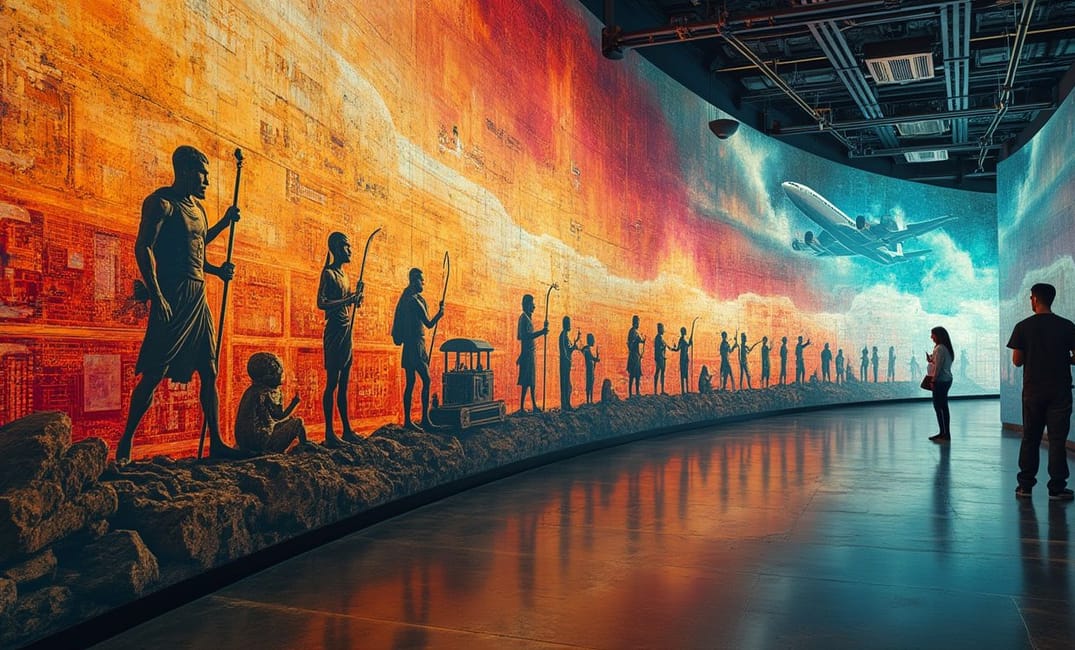Introduction: The Ever-Transforming Landscape of Human Ingenuity
Innovation is a cornerstone of the human journey—a continuous odyssey characterized by extraordinary creativity, exploration, and transformation. It is a narrative intertwined with both triumphs and challenges, driven by the relentless pursuit of betterment and knowledge. From the first flicker of fire to the mysteries of quantum computing, human ingenuity constantly shapes, redefines, and enriches the fabric of civilization. In this entry, we delve into the echoes of human innovation—tracing the developmental trajectories that have inspired change and preserved hope through epochs past and futures yet to come.
Ancient Sparks: The Genesis of Human Innovation
Primitive Tools and the Dawn of Technology
- From Stone to Metal: The creation of simple stone tools marked the inception of human innovation, laying a foundation for survival, adaptability, and community growth. Subsequent transitions, such as the innovation from stone to metal and the mastery of metallurgy, accelerated technological advancement and trade across cultures.
- Fire Mastery and Its Cultural Impact: The control of fire heralded a fundamental transformation, influencing food preparation, protection, and social dynamics. Fire not only allowed early humans to survive harsher climates but also enabled communal gatherings around central hearths, fostering social bonds and storytelling.
Agriculture and Settlements
- Agricultural Revolution: The shift from nomadic lifestyles to agrarian societies catalyzed urbanization and specialization. With controlled cultivation and domestication of plants and animals, societies achieved food surpluses, facilitating trade networks, societal growth, and technological development.
- Innovations in Irrigation and Construction: Ingenious irrigation methods and architectural innovations supported thriving civilizations in regions such as Mesopotamia and the Indus Valley. From ziggurats to pyramids, construction technology signified humanity's growing ability to manipulate environments and express collective cultural identities.
The Middle Ages to the Renaissance: Ingenuity Through Turbulent Times
The Transmission of Knowledge
- The Global Influence of Eastern Innovations: The spread of ideas and technologies from Eastern cultures, such as paper-making and gunpowder from China and mathematical concepts from the Islamic Golden Age, catalyzed European intellectual awakening and scientific pursuits.
- Medieval Engineering and Architecture: The Middle Ages witnessed architectural marvels, including fortifications, cathedrals, and bridges. Innovations in engineering, such as the use of flying buttresses in Gothic cathedrals, played crucial roles in shaping both the aesthetic and functional aspects of societal infrastructure.
The Renaissance: A Flourishing of Ideas
- The Printing Revolution: Johannes Gutenberg's introduction of the movable type revolutionized information dissemination, enabling widespread accessibility to books and knowledge, which nurtured the reformation, scientific inquiry, and critical thought.
- Artistic and Scientific Synergy: The Renaissance celebrated humanism and exploration. Luminaries like Leonardo da Vinci harmonized art and science, embodying a curiosity-driven approach that would inspire innovation beyond intellectual divides and foster new inquiries into the natural world.
The Industrial Age: Transformations in Technology and Society
The Birth of Industry
- The Steam Engine and Mechanization: James Watt’s improvements to the steam engine accelerated mechanization, propelling the Industrial Revolution forward. Factories became centers of production, altering labor dynamics and urban landscapes.
- Advancements in Transportation: Pioneering efforts saw breakthroughs in transportation, from locomotives and steamships connecting distant lands to the advent of the automobile, which redefined mobility, time efficiency, and societal structures.
Communication and Innovation
- Telecommunications’ Dawn: The telegraph and later the telephone redefined communication, bridging great distances and facilitating real-time exchange of information. These innovations marked the beginning of the global interconnectedness that continues to evolve today.
- The Electricity and Steel Revolutions: Innovations like electrical power generation and mass-produced steel revolutionized industries and everyday life, enabling new economic opportunities and technologies to build expansive infrastructure.
The 20th Century: Launching Modernity's Ascent
Flying and Computing Machines
- The Wright Brothers and Aviation: The achievement of powered flight in 1903 by Orville and Wilbur Wright ushered in the age of aviation, transforming wars, travel, and cultural exchange as borders diminished before the winged fury of flight.
- The Rise of Computing: Pioneering work in computing, from Alan Turing’s conceptual framework to the development of ENIAC, laid the groundwork for modern computer science. Computers evolved from computational behemoths to integral facets of daily life, revolutionizing fields from sciences to arts.
Medical and Scientific Breakthroughs
- Penicillin’s Discovery and Antibiotics: Alexander Fleming’s discovery of penicillin brought a new era in medicine, saving countless lives and vastly improving public health. Antibiotics mitigated infections that once claimed significant lives, illustrating innovation’s profound societal impact.
- Nuclear Technology: The enigma of the atom unlocked incredible energies—with both destructive velocities in wartime applications and foundational roles in peaceful endeavors, such as energy generation, challenging moral and ethical norms.
The Contemporary Era: Into the Futurescape
The Digital Revolution
- Internet and Connectivity: The internet emerged as the most transformative communication tool since the printing press, facilitating instantaneous exchange, commerce, and cultural dialogue globally. Social networks and mobile technology echo endlessly, weaving new digital realms of human connection.
- Artificial Intelligence: AI’s evolution revolutionizes industries and lifestyles, from practical applications in healthcare and automation to philosophical questions about consciousness and the essence of intelligence. The challenge lies in fostering AI’s responsible development and management to amplify human potential.
Sustainability and Future Technologies
- Green Technologies: Responding to environmental crises, green innovations seek sustainable solutions, from solar and wind energy to electric vehicles, aspiring towards global sustainability without sacrificing economic growth.
- Quantum Computing: At the frontier, quantum computing promises exponential processing capabilities beyond classical possibilities, potentially revolutionizing cryptographic systems and scientific inquiries.
Conclusion: The Ever-Evolving Quest for Progress
As flickers of innovation illuminate the past, present, and future, the human capacity for ingenuity demonstrates adaptability, resilience, and perseverance against challenges. From meticulously crafted primitive tools to future-shaping quantum endeavours, humanity harnesses creativity as a navigator through trials wrought by destiny's unpredictable seas. By preserving a legacy of ingenuity and transformation, the human narrative extends beyond survival toward evolution—a transcendent quest promising infinite possibilities amidst an ever-dynamic paradox of invention.
"In the heart of every innovation resides the spirit of change—a relentless pursuit of pushing beyond the known into a tapestry of dreams and discoveries yet woven. In every echo of progress, humanity finds itself reborn, resplendent with new horizons."
HISTORY, TECHNOLOGY, ANCIENT CIVILIZATIONS, SUSTAINABILITY, HUMAN INGENUITY, INNOVATION, DIGITAL REVOLUTION, INDUSTRIAL REVOLUTION, QUANTUM COMPUTING, SOCIETAL CHANGE

